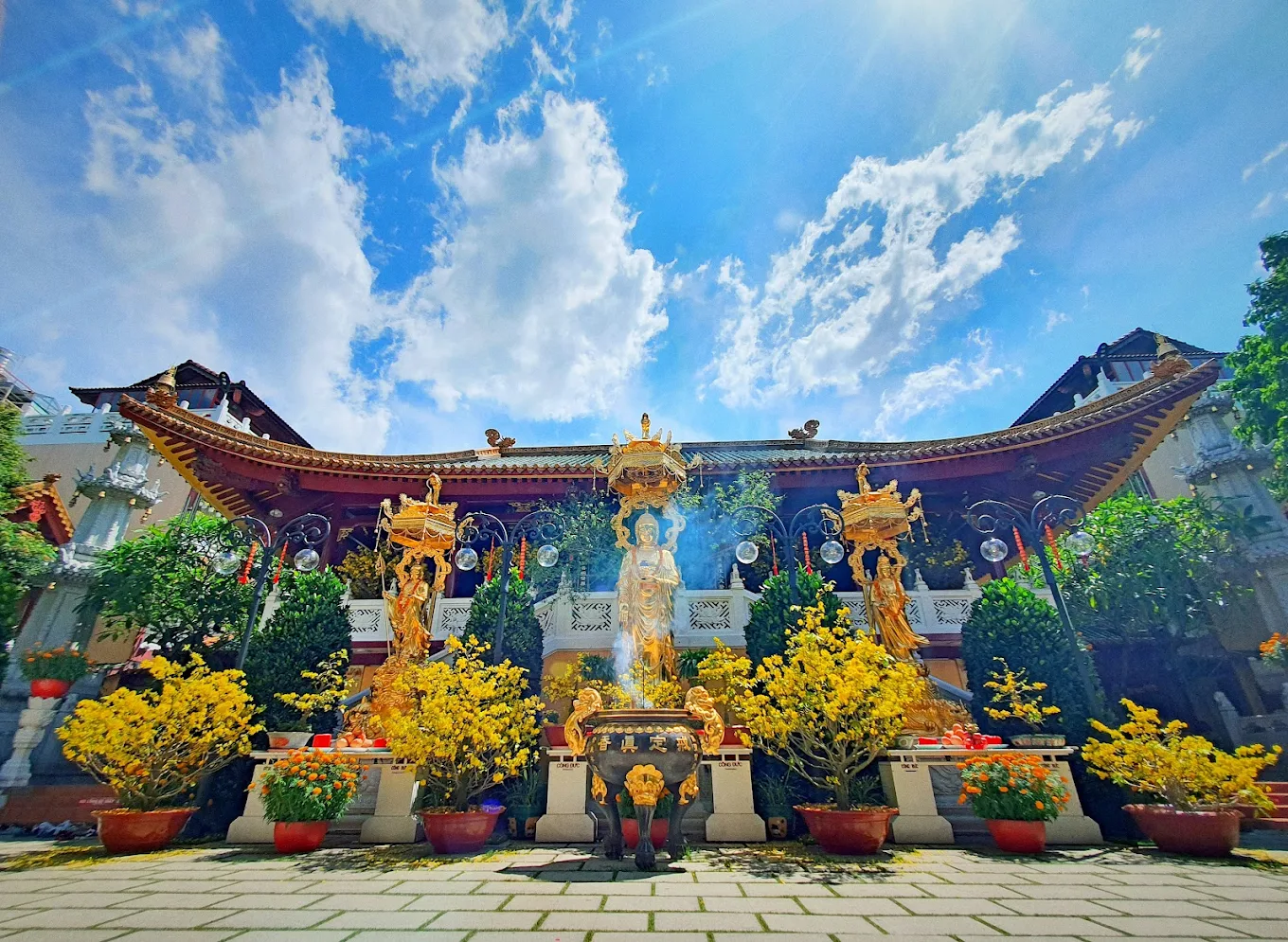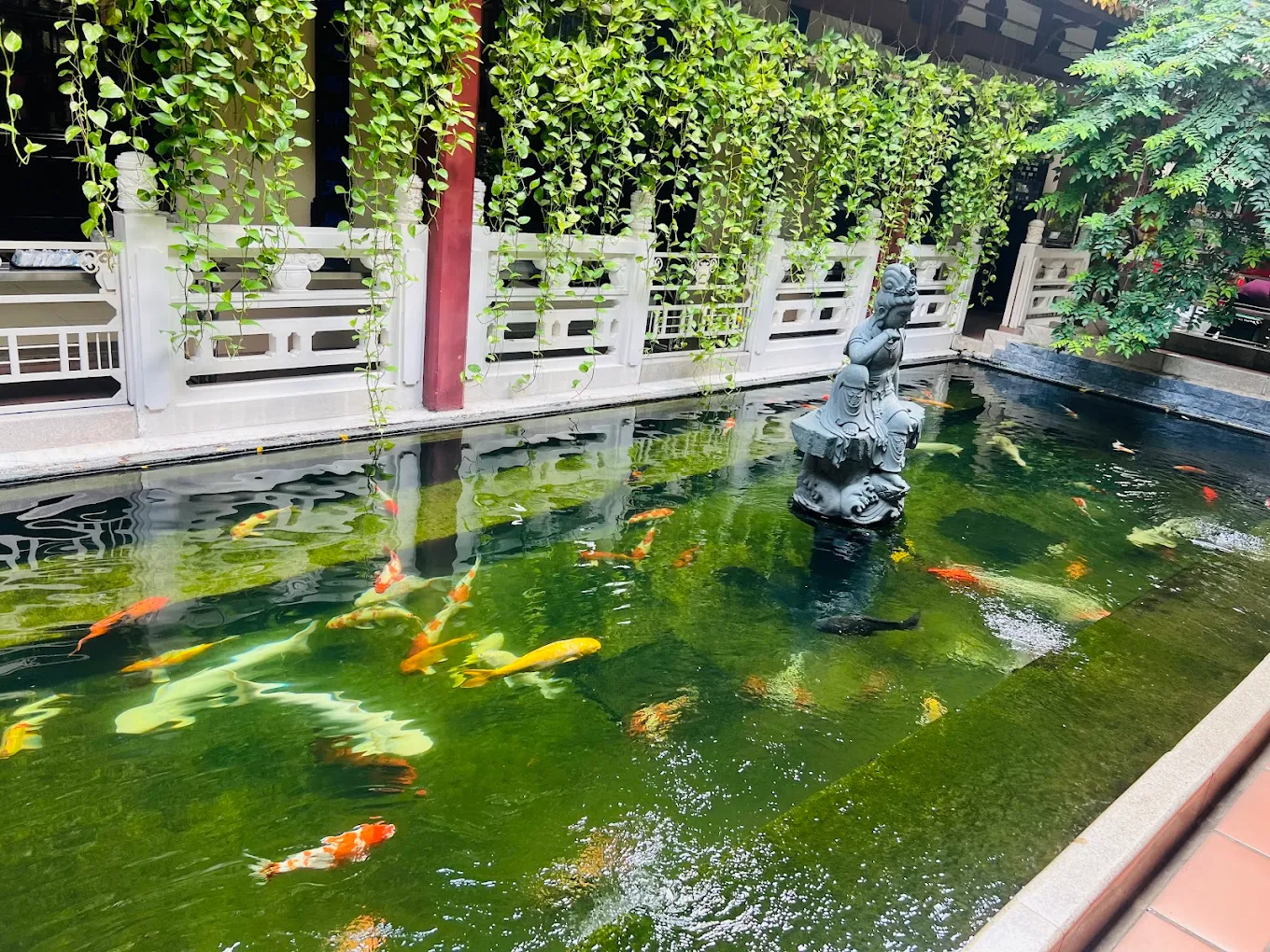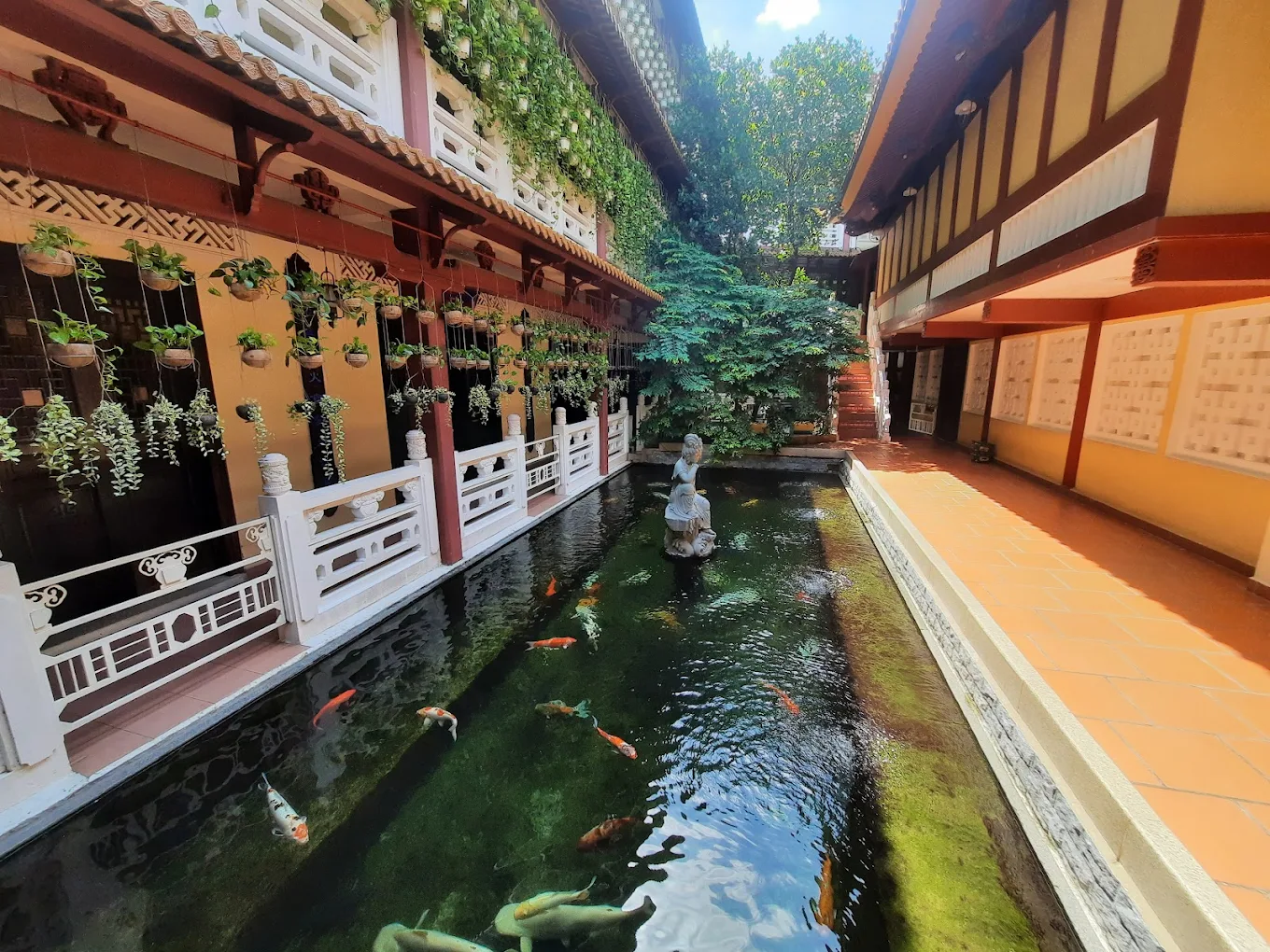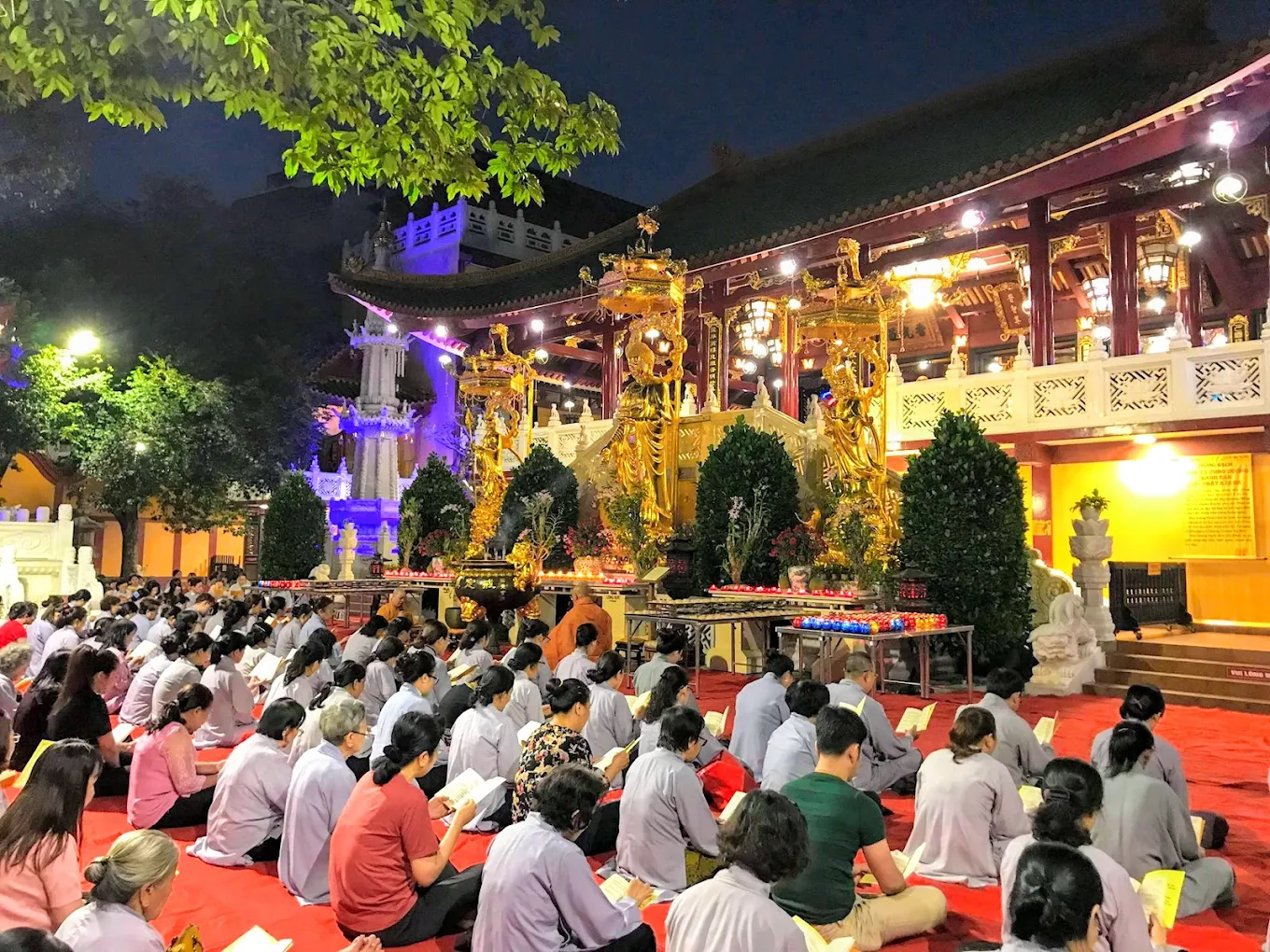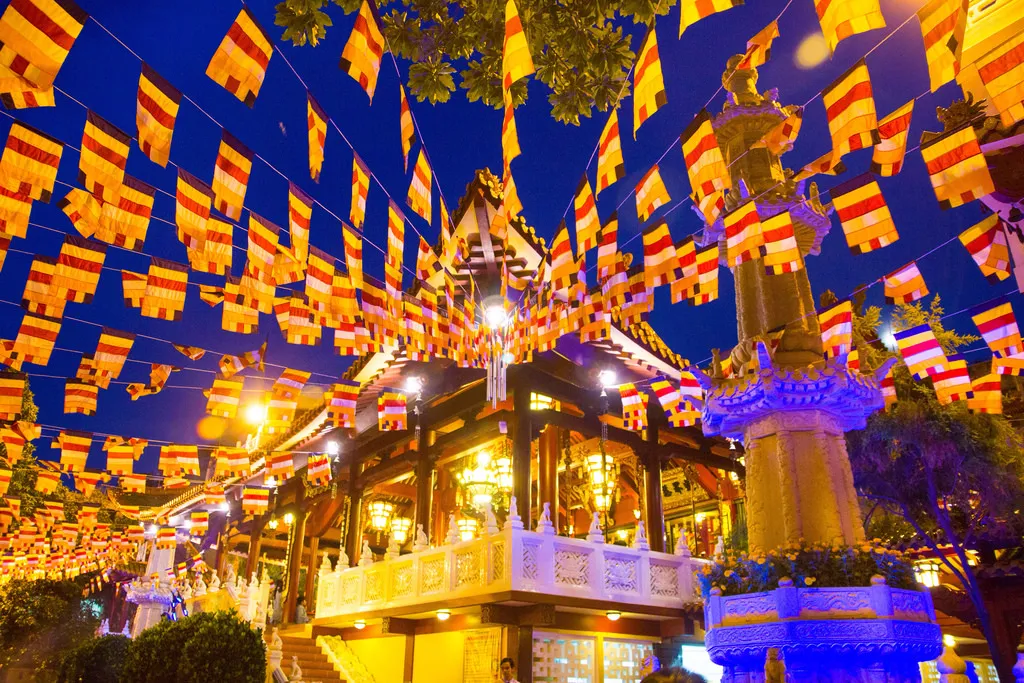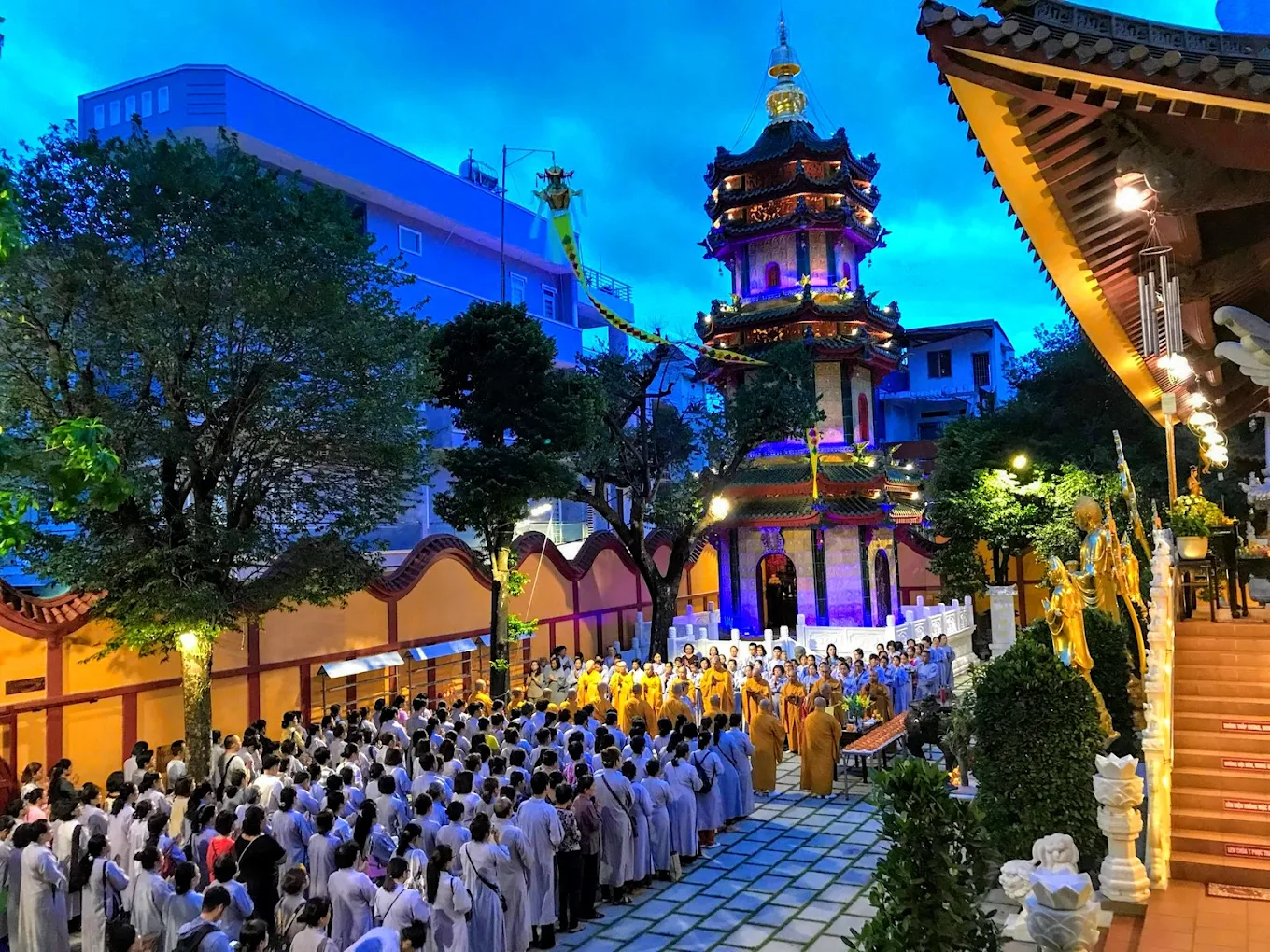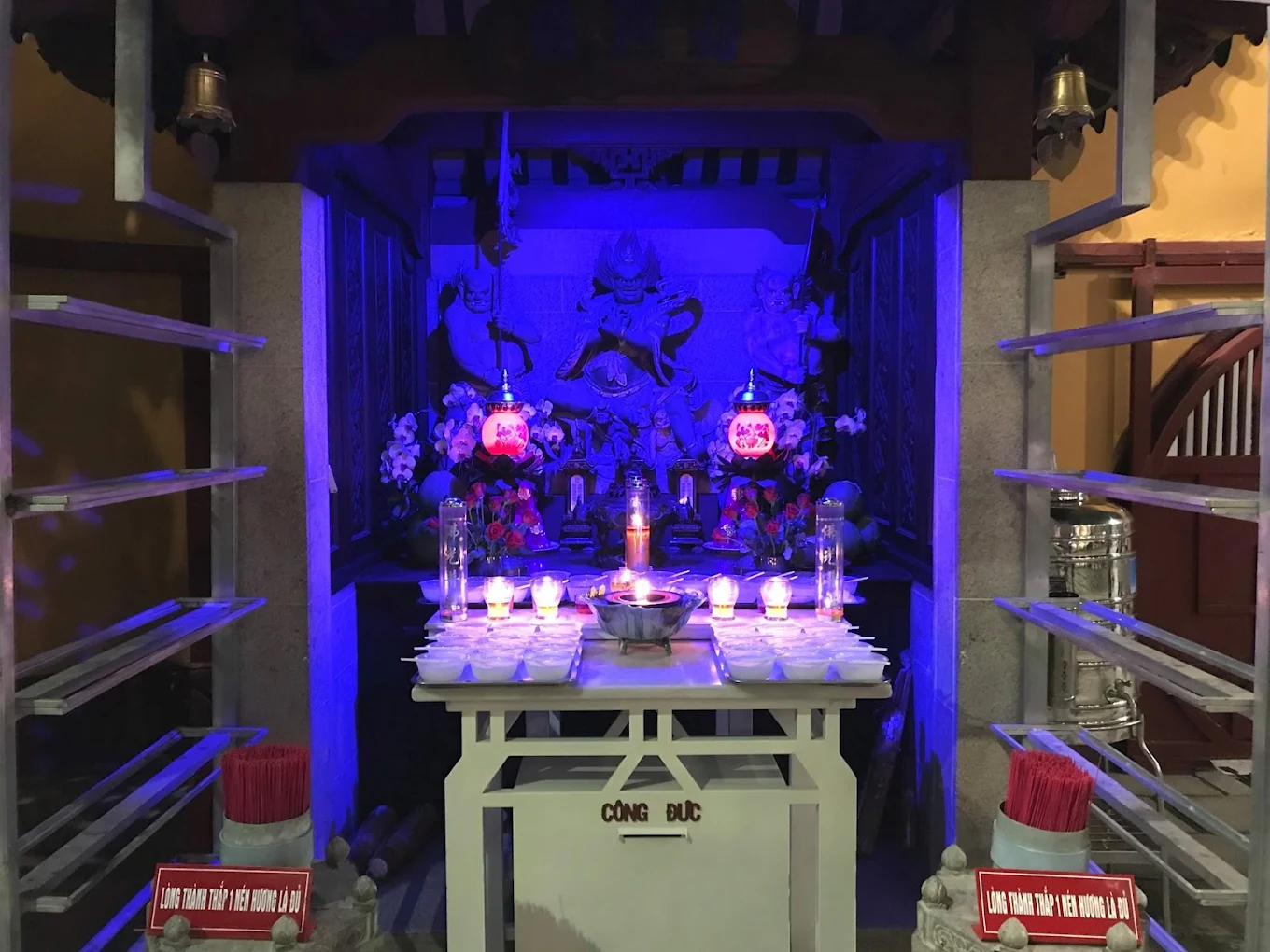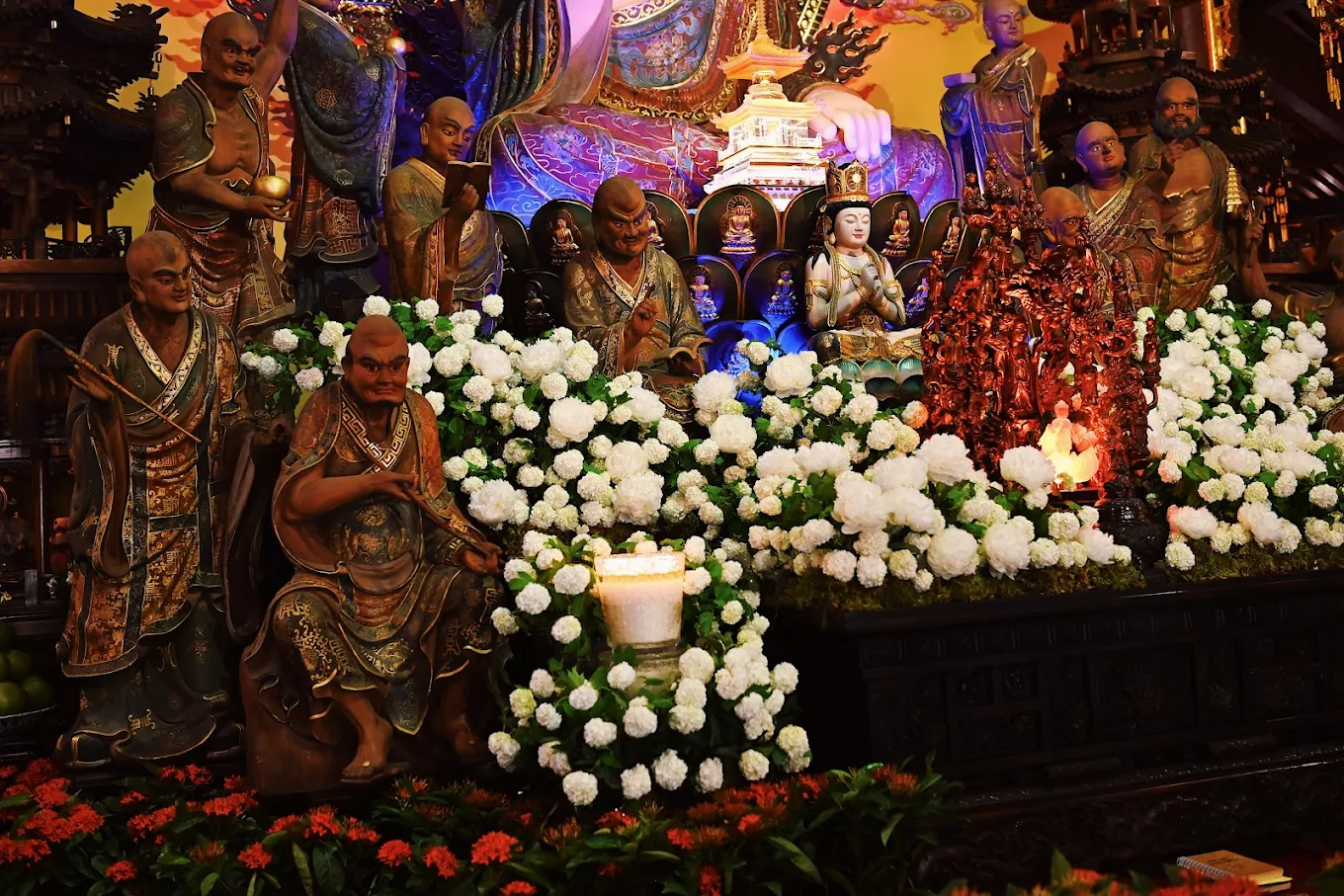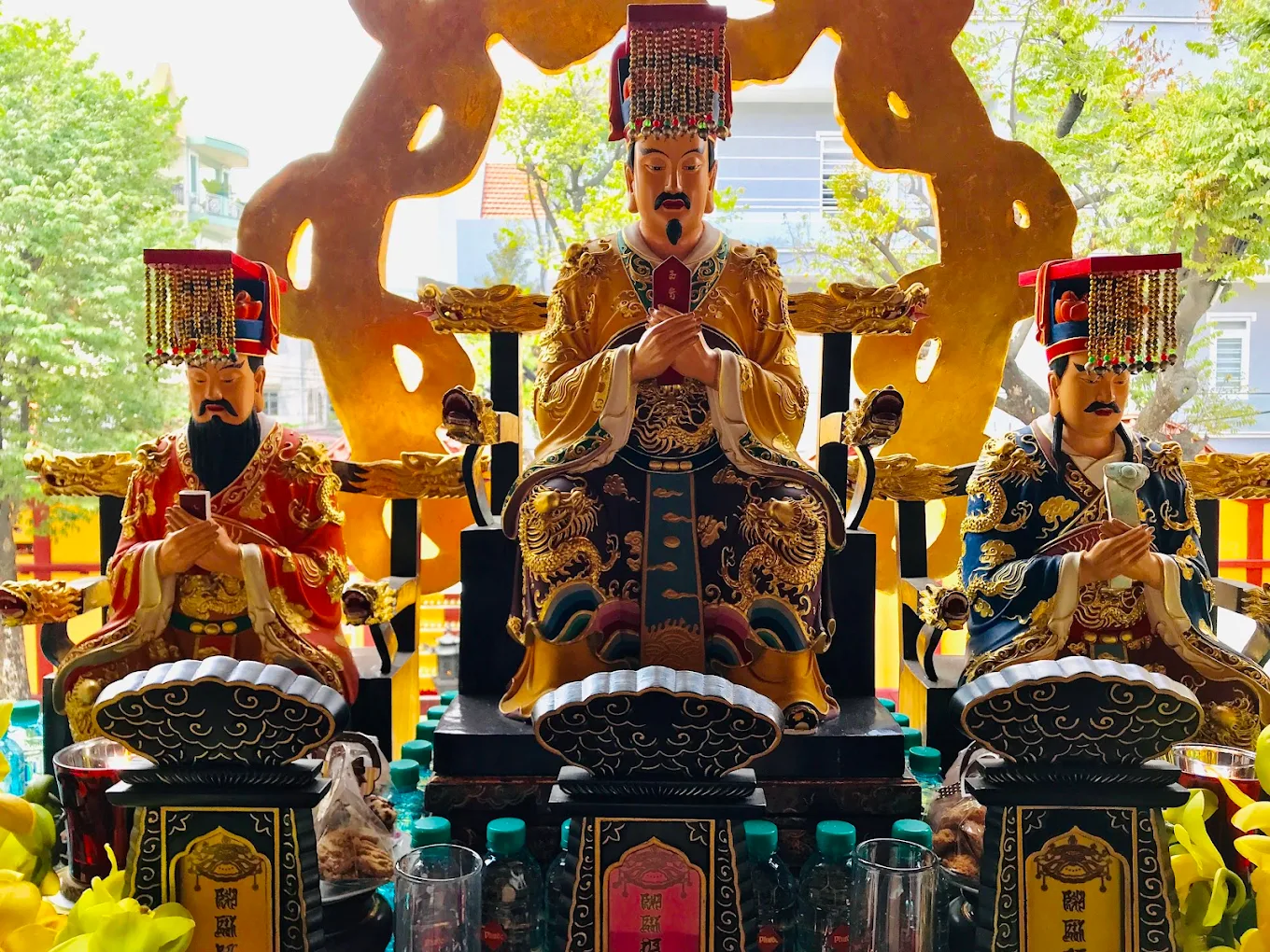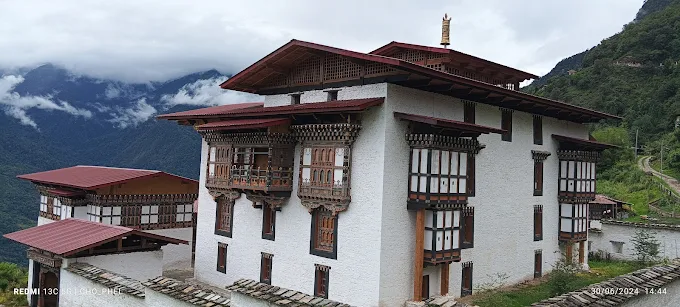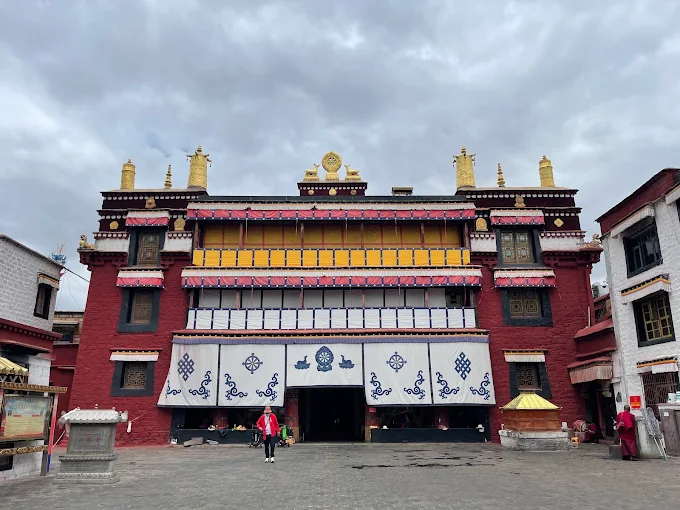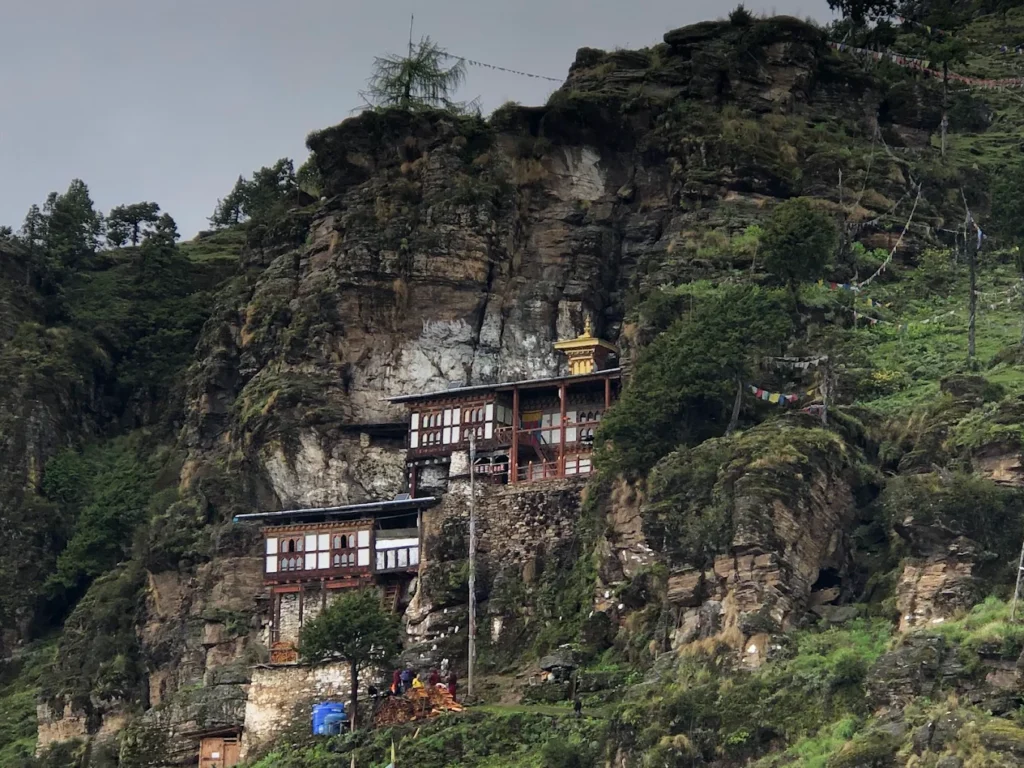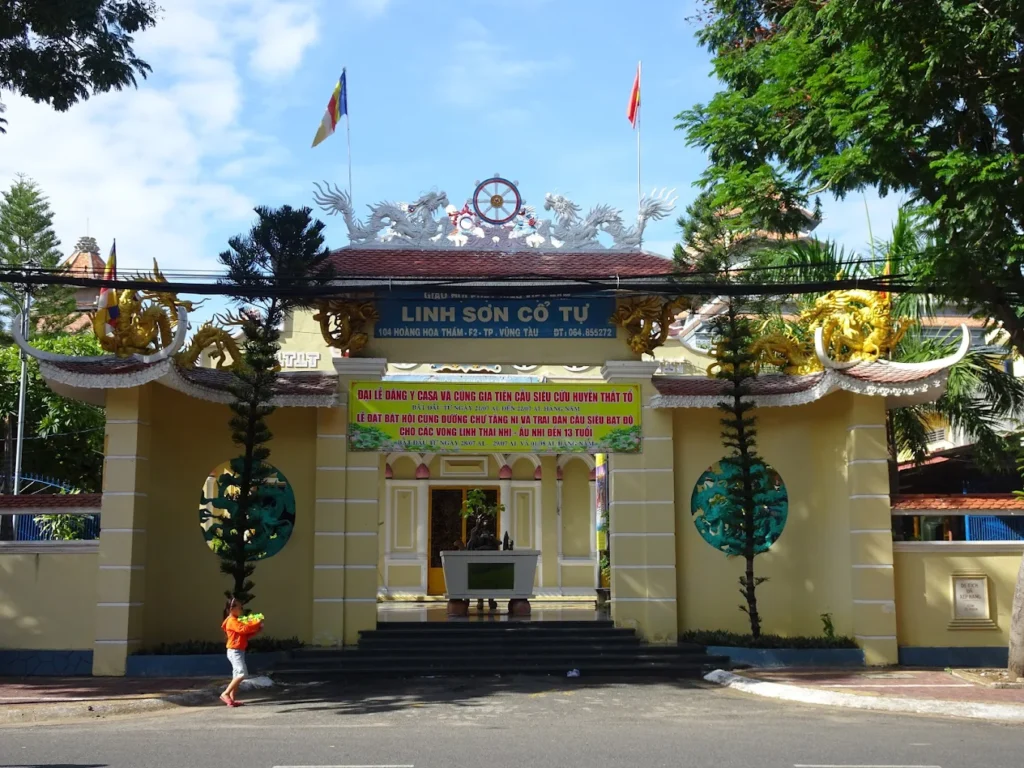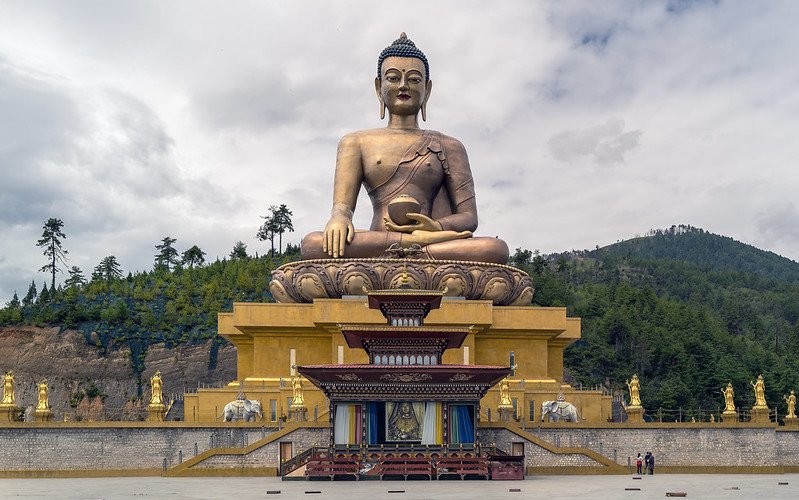Viên Giác Pagoda: The Radiant Ceramic Tower of Tan Binh’s Buddhist Serenity
In the vibrant heart of Tan Binh District, a temple bell’s resonant chime cuts through the morning bustle, guiding visitors to the tranquil courtyard of Viên Giác Pagoda. Saffron-robed monks move with quiet grace, arranging butter lamps [đèn bơ] before a golden Buddha Shakyamuni, his serene gaze radiating boundless compassion. The delicate scent of sandalwood incense weaves through the air, harmonizing with the rhythmic chants of the Medicine Buddha Sutra [Dược Sư kinh], a Northern Mahayana prayer invoking healing and peace. Soaring 22 meters above, the Radiant Light [Đẳng Quang] ceramic tower, Vietnam’s tallest, gleams with intricate ceramic carvings [khắc gốm] of Bodhisattvas, its hand-fired tiles catching the dawn’s first light. Nestled near Phạm Văn Hai Market, this sacred haven offers a quiet refuge from Ho Chi Minh City’s relentless energy, inviting reflection and reverence for those exploring the Viên Giác Pagoda listing.
Overview and Significance
Introduction to Viên Giác Pagoda
Viên Giác Pagoda, a cornerstone of Northern Mahayana Buddhism in Ho Chi Minh City’s Tan Binh District, stands as a beacon of spiritual and cultural heritage, renowned for its 22-meter Radiant Light ceramic tower, the tallest of its kind in Vietnam. Founded in 1955 by Venerable Thích Hồng Tịnh, the temple’s name, Complete Enlightenment [Viên Giác], embodies the Mahayana ideal of universal awakening, where practitioners vow to attain enlightenment for the benefit of all sentient beings. Northern Mahayana, or Bắc Tông, emphasizes compassion, wisdom, and the bodhisattva path, principles woven into the temple’s rituals, architecture, and community life. A vital hub for the Viên Giác Pagoda listing, it draws thousands annually for prayer, meditation, and festivals, blending East Asian [Á Đông] architectural elegance with modern Vietnamese craftsmanship. Its serene presence amid Tan Binh’s urban bustle offers solace to locals, pilgrims, and global visitors, cementing its role as a cultural and spiritual landmark.
Historical Journey
Viên Giác Pagoda’s history traces a remarkable arc from a modest hermitage to a cultural icon, reflecting Vietnam’s spiritual resilience through decades of change. In 1955, Venerable Thích Hồng Tịnh established Solitary Enlightenment [Độc Giác] hermitage, a small wooden structure on Bùi Thị Xuân Street, designed for personal meditation during Vietnam’s post-colonial turmoil. The hermitage, with its thatched roof and single altar, served as a sanctuary for monks and local devotees seeking peace in a fractured era. By 1976, under Venerable Thích Minh Phát’s leadership, the temple was renamed Viên Giác, symbolizing a shift to collective enlightenment, and the main hall [chánh điện] was expanded with community donations to accommodate a growing congregation drawn to its healing-focused practices. This expansion included a larger altar for the Buddha Shakyamuni statue and space for communal prayers, marking the temple’s rise as a spiritual center in Tan Binh District.
From 1996 to 1999, under Venerable Thích Lệ Trang’s leadership, Tan Binh’s Buddhist community united to fund the Radiant Light tower’s construction, overcoming economic hardships through small donations from families, some contributing a day’s wages, reflecting their collective devotion to preserving Viên Giác Pagoda’s spiritual legacy. The tower’s completion in 1999 marked a milestone, earning national recognition as Vietnam’s tallest ceramic structure. Today, Venerable Thích Đồng Văn, the fourth abbot, alongside Venerable Thích Trí Thông, guides the temple, fostering community engagement through lectures, charity, and preservation efforts. The temple endured wartime disruptions in the 1960s and 1970s, with monks safeguarding sacred relics by hiding them in the hermitage’s foundation. Minor renovations in the 1980s repaired bomb-damaged roofs, ensuring continuity. These pivotal moments underscore Viên Giác Pagoda’s enduring role in Tan Binh’s spiritual landscape, making it a focal point for the Viên Giác Pagoda history.
Cultural Significance
Viên Giác Pagoda serves as a spiritual anchor in Tan Binh District, offering a serene retreat near the bustling Phạm Văn Hai Market, where vendors’ calls contrast with the temple’s quiet reverence. Its daily Medicine Buddha Sutra recitations, a hallmark of Northern Mahayana practice, resonate with devotees seeking health, peace, and spiritual renewal, reinforcing Vietnam’s deep-rooted Buddhist heritage. The temple’s annual festivals, such as Tết (Lunar New Year), Vesak (Buddha’s Birthday), and Vu Lan Festival [Lễ Vu Lan], a Northern Mahayana celebration held in the seventh lunar month to honor ancestors and express filial piety, rooted in the story of Maudgalyayana saving his mother from suffering as described in the Ullambana Sutra, draw thousands from Ho Chi Minh City and beyond. Families offer rice, flowers, and candles to commemorate loved ones, seeking their spiritual liberation, making Vu Lan Festival a profound expression of Vietnam’s cultural and spiritual values. The Radiant Light tower, a national record holder, showcases Vietnam’s gốm artistry, blending traditional Bát Tràng ceramic carvings with modern design, influencing local cultural identity and inspiring artisans across southern Vietnam. As a hub for the Viên Giác Pagoda listing, the temple attracts global visitors, from Buddhist pilgrims to cultural researchers, bridging Vietnam’s past and present.
Unique Legacy
Viên Giác Pagoda’s legacy is defined by its seamless blend of spirituality, artistry, and community resilience:
- Radiant Light Tower: Completed in 1999, this 22-meter ceramic structure houses sacred Buddha relics, symbolizing purity and enlightenment. Its 1,000 hand-fired ceramic carvings, depicting Bodhisattvas, reflect Northern Mahayana’s emphasis on compassion and wisdom.
- Community Endurance: The temple’s survival through Vietnam’s turbulent 20th century, from wartime bombings to economic reforms, showcases collective faith, with devotees rebuilding it through grassroots donations.
- Artistic Innovation: The tower’s ceramic carvings, crafted by Bát Tràng artisans, merge traditional firing techniques with modern aesthetics, setting a standard for Vietnamese temple design.
This legacy draws scholars, artists, and devotees to explore the Viên Giác Pagoda history, cementing its role as a cultural and spiritual landmark.
Community and Global Impact
Viên Giác Pagoda fosters deep community ties in Tan Binh District, hosting weekly sutra recitations and monthly Buddhist ethics lectures that engage hundreds of local devotees, promoting mindfulness and unity. During festivals like Tết, Vesak, and Vu Lan Festival, Vietnamese diaspora from countries such as Australia, Canada, and the United States return to pray, strengthening cultural bonds. The Radiant Light tower’s record-breaking status attracts international Buddhist scholars, enhancing the temple’s global profile for the Viên Giác Pagoda listing. Charitable initiatives, such as distributing rice and essentials to Tan Binh’s urban poor, embed the temple in its community.
Historical Anecdotes
- Venerable Thích Hồng Tịnh’s Vision: Oral histories recount his meditations in the Solitary Enlightenment hermitage, inspired by a vision of radiant light, laying the temple’s spiritual foundation.
- 1996–1999 Community Effort: Under Venerable Thích Lệ Trang, families donated small sums to build the Radiant Light tower, reflecting collective devotion despite economic hardships.
- Wartime Resilience: During the Vietnam War, monks hid relics in the hermitage’s foundation, preserving the temple’s sacred heritage.
These anecdotes enrich the Viên Giác Pagoda history, offering vivid glimpses into its resilience.
Social Role
Viên Giác Pagoda organizes charitable events like Tết food distributions, supporting hundreds of families in Tan Binh District. Weekly Buddhist ethics lectures foster mindfulness, while festival gatherings strengthen social bonds, ensuring the temple’s role as a center for the Viên Giác Pagoda listing.
Artistic Influence
The Radiant Light tower’s ceramic carvings inspire Bát Tràng artisans, influencing modern temple designs in southern Vietnam. Local art exhibitions feature replicas of the tower’s Bodhisattva tiles, showcasing the Viên Giác Pagoda architecture’s cultural impact.
Viên Giác Pagoda’s history and cultural significance flow seamlessly into its architectural marvels, where spirituality and artistry intertwine.
Architectural and Spiritual Features
Iconic Design
Viên Giác Pagoda’s mountain-shaped layout [chữ Sơn], spanning 1,500 square meters, follows a traditional Vietnamese architectural pattern with three parallel structures, symbolizing stability and balance, evoking the steady ascent toward enlightenment. The temple’s warm palette of gold, brown, and red gạch tiles creates an inviting atmosphere, blending East Asian architectural elegance with modern construction techniques suited to Ho Chi Minh City’s humid climate. Curved rooflines, adorned with lotus motifs, represent the Buddhist journey from adversity to purity, their gentle arcs standing out against Tan Binh’s urban skyline. The open courtyard, framed by banyan trees, balances the district’s density with serene openness, making Viên Giác Pagoda architecture a spiritual focal point for devotees and cultural enthusiasts.
Key Structures
- Main Hall: The central worship space, with high wooden beams and a polished tile floor, houses the Buddha Shakyamuni statue, surrounded by intricate lotus carvings symbolizing purity. Its high ceiling amplifies sutra chants, creating an immersive spiritual experience.
- Radiant Light Tower: A 22-meter ceramic structure, completed in 1999, features three tiers and seven roofs, representing the Three Jewels (Buddha, Dharma, Sangha) and seven levels of consciousness. Its ceramic carvings gleam under sunlight.
- Lecture Hall: A modest building with wooden panels, used for teachings, adorned with floral designs echoing the courtyard’s lotus pond.
- Tiếp Dẫn Hall: A secondary shrine for Amitabha Buddha, housing ancestral tablets, with sandalwood accents enhancing its serenity.
These structures anchor the Viên Giác Pagoda architecture’s spiritual role.
Worshipped Statues/Deities
- Buddha Shakyamuni: A 2-meter gold-plated statue in the main hall, carved from jackfruit wood [gỗ mít], depicts the Dharmachakra mudra, symbolizing wisdom. Its serene expression draws devotees seeking inner peace.
- Amitabha Buddha: A 1.5-meter sandalwood statue in the Tiếp Dẫn hall, representing Pure Land salvation, radiates hope.
- Eighteen Arhats [Thập Bát La Hán]: Wooden statues line the main hall, symbolizing diverse paths to liberation.
These figures inspire reverence for the Viên Giác Pagoda listing.
Materials and Techniques
The Radiant Light tower’s 1,000 Bát Tràng ceramic tiles withstand humidity, while jackfruit wood statues are gilded for radiance. The 1996 rebuild blended modern engineering with East Asian aesthetics, ensuring durability.
Signature Elements
The Radiant Light tower’s ceramic carvings, housing Buddha relics, symbolize enlightenment, distinguishing Viên Giác Pagoda architecture with its seven lotus-adorned roofs.
Lesser-Known Features
- Lotus Carvings: Wooden panels in the lecture hall depict purity.
- Relic Shrine: A discreet altar in the tower holds sacred ashes.
- Banyan Tree Inscriptions: Carved prayers reflect community faith.
These elements enrich the Viên Giác Pagoda listing.
Preservation Efforts
Community funding in 1999 protected the tower’s ceramic carvings, with monks maintaining tiles using Bát Tràng techniques. Roof reinforcements ensure longevity.
Environmental Integration
Banyan trees and a lotus pond create a tranquil retreat, symbolizing interconnectedness and purity for the Viên Giác Pagoda visit.
Artisan Narratives
Bát Tràng artisans, led by Nguyễn Văn Hòa, embedded prayers in the tower’s ceramic carvings, reflecting devotion to the Viên Giác Pagoda architecture.
Symbolic Details
The tower’s seven roofs symbolize consciousness levels, while lotus carvings represent purity, deepening the Viên Giác Pagoda architecture’s resonance.
Landscape Integration
The courtyard’s banyan trees and lotus pond shield the temple from urban noise, fostering meditation for the Viên Giác Pagoda visit.
The temple’s architectural splendor sets the stage for its vibrant rituals, inviting engagement with its Northern Mahayana traditions.
Rituals and Practices
Daily Sacred Rites
Each morning, monks chant the Medicine Buddha Sutra in the main hall, with butter lamps illuminating the Buddha Shakyamuni statue, anchoring the Viên Giác Pagoda rituals in healing and compassion.
Unique Practices
- Medicine Buddha Sutra Recitation: A Northern Mahayana rite invoking healing, unique to Viên Giác Pagoda’s focus.
- Relic Veneration: Incense offerings at the tower’s relic shrine connect devotees to the Buddha’s legacy.
- Morning Meditation: Guided sessions foster mindfulness, open to visitors.
These practices distinguish the Viên Giác Pagoda rituals.
Festival Traditions
- Tết (Lunar New Year): Vibrant decorations and sutra recitations unite thousands in prayers for prosperity.
- Vesak (Buddha’s Birthday): Lanterns and Buddha bathing ceremonies celebrate enlightenment.
- Vu Lan Festival: Families offer rice and candles to honor ancestors, seeking their liberation.
These festivals highlight the Viên Giác Pagoda rituals’ communal role.
Visitor Engagement
Visitors join morning sutra recitations or light butter lamps, deepening their connection to the Viên Giác Pagoda rituals with respectful participation.
Spiritual Community Roles
- Monks: Lead rites and teachings.
- Devotees: Organize festivals, strengthening community bonds.
- Lay Practitioners: Lead study groups, sharing Mahayana teachings.
These roles sustain the Viên Giác Pagoda listing’s vibrancy.
Interfaith Connections
The temple welcomes non-Buddhists during Tết and Vu Lan Festival, fostering harmony through shared rituals.
Ritual Symbolism
The Medicine Buddha Sutra’s seven Buddhas mirror the tower’s seven roofs, symbolizing spiritual progression for the Viên Giác Pagoda rituals.
Seasonal Variations
Tết features vibrant feasts, Vesak serene lanterns, and Vu Lan solemn prayers, reflecting cultural rhythms.
Monastic/Community Life
Monks meditate at dawn, while devotees maintain the temple, ensuring the Viên Giác Pagoda rituals’ vitality.
The temple’s rituals guide visitors toward practical engagement with its sacred spaces.
Visitor Information
Navigating to Viên Giác Pagoda
A short walk from Phạm Văn Hai Market along Bùi Thị Xuân Street leads to the temple’s lotus-relief gate, ideal for the Viên Giác Pagoda visit.
Address of Viên Giác Pagoda
193 Bùi Thị Xuân, Ward 1, Tan Binh District, Ho Chi Minh City, Vietnam.
Visiting Hours and Etiquette
- Hours: 7:00 a.m.–6:00 p.m., extended during festivals.
- Etiquette: Remove shoes, dress modestly, maintain silence.
Transport Options
- Motorbike: Parking available.
- Taxi/Grab: 15-minute ride from District 1.
- Bus: Route 104 stops nearby.
Accessibility and Safety
- Accessibility: Flat courtyard aids mobility; tower stairs may challenge some.
- Safety: Secure area, but watch for traffic.
Amenities and Surroundings
- Amenities: Restrooms and tea stall.
- Surroundings: Phạm Văn Hai Market offers street food.
Immersive Visitor Tips
Join sutra recitations or photograph the tower’s ceramic carvings at dusk for the Viên Giác Pagoda visit.
Nearby Cultural Experiences
- Phạm Văn Hai Market: Local cuisine, 0.5 km.
- Ho Chi Minh City Museum: History exhibits, 3 km.
Photography Tips
Capture the tower’s ceramic carvings in natural light, avoiding flash near statues.
The temple’s practical guidance invites deeper exploration of its spiritual significance.
Cultural and Spiritual Insights
Religious Philosophy
Northern Mahayana’s bodhisattva path emphasizes compassion, reflected in the Medicine Buddha Sutra’s healing focus, guiding the Viên Giác Pagoda listing.
Environmental Spirituality
Banyan trees and the lotus pond symbolize interconnectedness and purity, enhancing the Viên Giác Pagoda visit.
Artistic Symbolism
The tower’s ceramic carvings represent enlightened qualities, deepening spiritual contemplation.
Community Resilience
The 1996–1999 community effort to build the tower showcases enduring faith.
Environmental Stewardship
Monks maintain the pond sustainably, reflecting Buddhist ecology.
Meditative Practices
Morning meditation sessions foster mindfulness for the Viên Giác Pagoda visit.
Cultural Narratives
Stories of Venerable Thích Hồng Tịnh’s vision enrich the Viên Giác Pagoda history.
Historical Context
The temple’s growth mirrors Vietnam’s Buddhist revival, anchoring the Viên Giác Pagoda listing.
These insights deepen appreciation for Viên Giác Pagoda’s role.
Conclusion
Viên Giác Pagoda, with its radiant ceramic tower and golden Buddha Shakyamuni, stands as Tan Binh’s spiritual heart, blending Northern Mahayana devotion with Vietnam’s gốm artistry. From its 1955 founding to its modern prominence, the temple reflects a community’s unwavering faith, its rituals and architecture weaving a tapestry of compassion and wisdom. The Radiant Light tower’s ceramic carvings and the courtyard’s serene lotus pond invite visitors to explore a sanctuary of peace, where the Medicine Buddha’s healing prayers and Vu Lan Festival’s filial reverence resonate. Viên Giác Pagoda remains a beacon of enlightenment, welcoming all to witness its tranquil embrace for the Viên Giác Pagoda listing.
